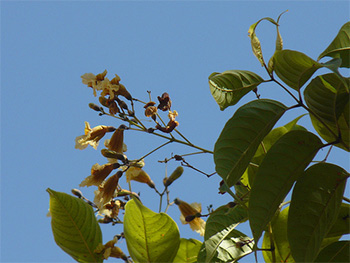Patala (Stereospermum suaveolens) – Uses, Benefits, Dosage and Medicinal Properties

Description of Patala Plant
Patala (Stereospermum suaveolens) tree is around 25m long. It is cylindrical in shape, extremely externally brown to creamy, rough due to vertical fissures, cracks, ridges and transverse fine lenticels, internally dark brown, lamellation of stratification due to presence of concentric bands of fibers.
General Description
Patala is a valuable herb in Ayurveda, known for its multiple therapeutic properties such as being a diuretic, cardiac tonic, and anti-inflammatory. Various parts of the plant are used for different medicinal purposes. The roots of Patala are particularly effective in balancing Vata dosha and are used in the management of Vata-related disorders. The flowers, on the other hand, are cool in potency and are beneficial in addressing blood-related disorders, making Patala a holistic remedy in traditional Ayurvedic practice.
Chemical Constituents
Patala Plant contains naphthoquinone lapachol. Patala Root bark contains 6-sitosterol, n-triacontanol. Root, heart-wood contains lapachol, dehydro-a-lapachone and dehydrotectol and the Leaves contain flavone glycoside scutellarein, dinatin-7-glucuronide. Seeds of the plant contain non-drying oil, Bitter substances, sterols, glycosides and glycoalkaloids. Its Root bark contains a bitter substance. Lapachol isolated which showed highly significant activity against walker 256 carcinoma. Lapachol, Scutellarein, Dehydrotectol, cetyl alcohol, oleic, Palmitic, Stearic acid.
It has two varieties mentioned by Bhavaprakasha as Patala and Sitapatala. Patala is identified as Stereospermum suaveolens and Sitapatala as Stereospermum chelonoides.
Classification
- Kingdom: Plantae
- Order: Lamiales
- Family: Bignoniaceae
- Genus: Stereospermum
- Species: S. chelonoides
Habitat
It is found in North circus and Deccan, in deciduous forests; Western Ghats and also in deciduous forests, in the hills of Mysore, Malabar and Travancore, Scarce.
Names
- Botanical Name: Stereospermum suaveolens
- Hindi Name: Padhal, Podal
- Telugu Name: Kaligottu, Padiri, Kaligottu, Kokkesa, Podira
- Bengali Name: Parul
- Punjabi Name: Padala
- Marathi & Gujarati Name: Padal
- Tamil Name: Padari
- Assamese Name: Parul
- English Name: Rose Flower Fragrant
- Kannada Name: Padramora
- Malayalam: Padiri
- Oriya Name: Boro, Patulee
- Punjabi: Padal
Ayurvedic Properties of Patala
| Hindi / Sanskrit | English | ||
| Rasa | Tikta, Kasaya | Taste | Bitter, Astringent |
| Guna | Laghu, Rooksha | Physical Property | Light, Dry |
| Virya | Anusna | Potency | Hot |
| Vipaka | Katu | Taste Conversion After Digestion | Pungent |
Note: its flower is Sheeta Virya in nature (coolant).
Patala Effects On Doshas
Patala is tridosahara i.e. balances all the three doshas (vata, pitta and kapha).
Classical Categorization
| Charak Samhita | Sushrut Samhita | Vagbhata |
|
Sothahara – Anti-Inflammatory group of herbs |
Aragvadhadi, Brihat pancha moola, Adhobhagahara |
Aragwadhadi |
Ancient Verse about Patala(Stereospermum suaveolens)

The Bhavprakash nighantu, edition of 1998: verse 19-22, page no-278-280.
It states the different names and properties of padal – patil, patala, amotha, maghudhut, faleruha, krishanvrinta, kuberakshi, kalsthali, alivallam and tamarpushpi.
It is bitter and astringent in taste and anusna (not very hot) in potency. It helps to balance all three doshas and manages the anorexia (aaruchi), asthma and bronchitis (shwas), inflammation and edema (shoth), vomiting (vaman), hiccups, blood disorders (raktprokap) and excessive thirst (trisha).
The properties of Patala flowers and Patala fruits are – Patala flowers are sweet and astringent in taste and cold in potency. It helps to maintain the kapha and pitta doshas. Patala fruit is used to manage hiccups and blood related disorders.
Reference
The Bhavprakash nighantu with elaborated Hindi commentary by Padmashri prof. K. C. Chunekar, edited by Dr. G. S. Pandey: edition of 1998: verse 19-22, page no-278-280.
Practical Uses Of Patala
- Diuretic – Being diuretic in nature, this herb helps in easy urination and maintains the proper urine flow. It also helps to provide relief in the burning sensation, difficulty in urination and frequent urination.
- Cardiac tonic –
- This herb has a great medicinal importance and acts as the cardiac tonic also. It helps to maintain good heart health as it helps in the strengthening of heart muscles and arteries. Moreover it also maintains good blood flow in the body.
- It is also used to treat anorexia and improves the appetite.
- Piles – This herb is quite effective in the treatment of piles. It helps to improve digestion and resolves the problem of constipation. This herb also provides relief from the problems like itching, irritation, redness, soreness and swelling around anus.
- Anti-inflammatory – It is used in the edema and helps in inflammatory conditions. It also reduces the pain.
- Blood purifier – It helps to remove toxins from blood and purifies it.
- It is helpful in difficult breathing, vomiting, hiccups and thirst.
- Blood disorders -Use of this herb is quite good in blood disorders like anemia. This herb enhances the production of Red Blood Cells. It also helps to provide relief in symptoms associated with anemia like fatigue, lethargy and weakness.
- It is useful in kapha and vata related disorders like inflammation, asthma, fever, blood related disorders.
- Root is coolant in nature and has diuretic properties.
- Bark is vata kapha shamaka.
- Fruits and flowers are vata pitta shamak.
- Its flowers are vajikar, paustika and sitala and are taken in the form of confection as aphrodisiac. It helps to improve semen quality.
- It is useful in gastritis and gastric ulcers.
Part Used
Root bark, flower, seed, leaf, kshara
Dosage
- Decoction: 50-100 ml
- Kshara: 1-2.5 gm
Patala Side Effects
No known side effects. Safe to use in lactation period and in children. To be used only under medical supervision during pregnancy.



